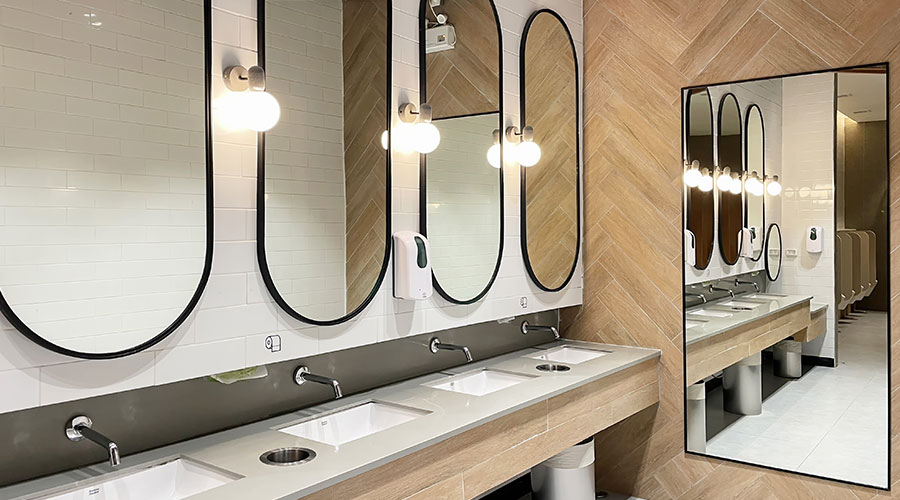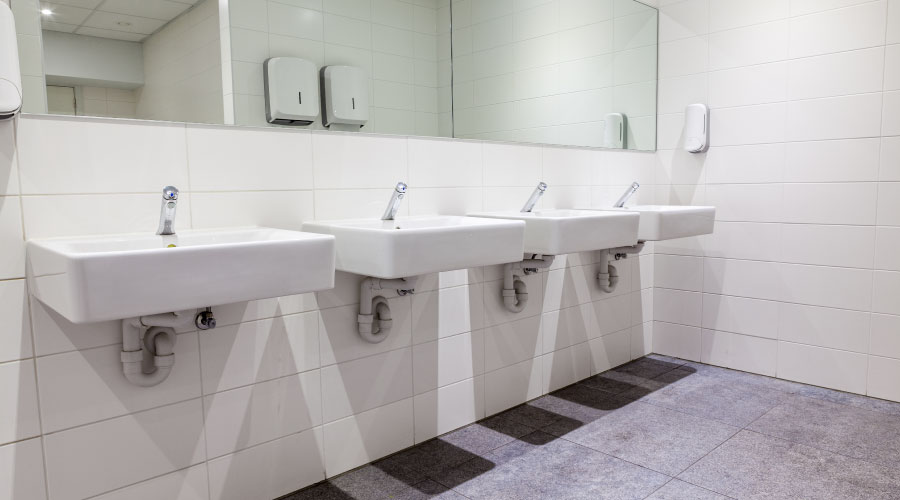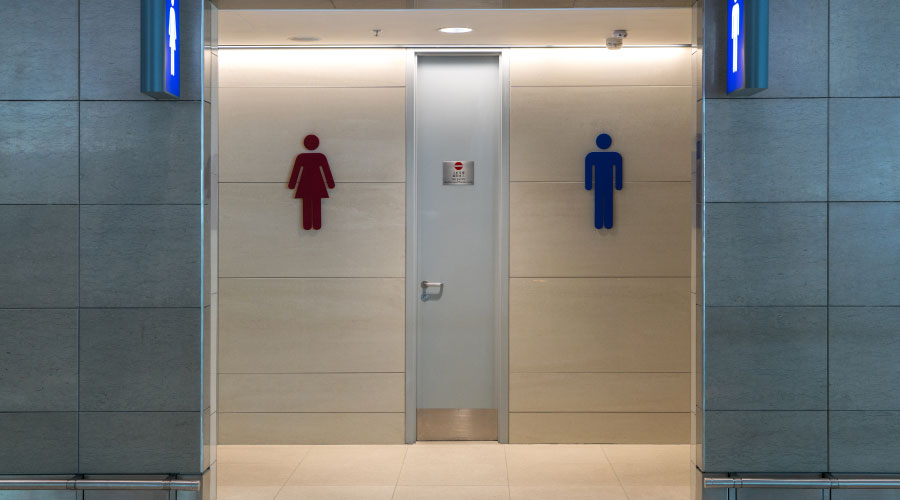Stemming the Flow
Rising costs are making water efficiency a priority. Cooling, irrigation and plumbing can provide opportunities for savings
By Greg Zimmerman, Executive Editor
When compared to some of the other hallmarks of green building, like energy efficiency or indoor environmental quality (IEQ), for example, water efficiency doesn’t always get its due. The reasons are plentiful; perhaps most dominant is the perception that compared with, say, an energy project, the cost savings from a water efficiency project can be a mere drop in the bucket.
“Water efficiency still doesn’t get respect,” says Tom Horner, vice president of Water Management Inc., a firm that helps organizations improve water efficiency. “A hospital could charge a little more for aspirin and make more money than any possible water efficiency measure can save.”
Water efficiency may also get short shrift because some facility executives have heard horror stories of water efficiency projects where costs spiraled out of control because the work required other unbudgeted upgrades. Also, building codes don’t always give the proper guidance on how to use new water efficiency technologies, making some organizations  nervous about liability, which usually torpedoes a project before it even gets started.
nervous about liability, which usually torpedoes a project before it even gets started.
Even the U.S. Green Building Council’s LEED for new construction rating system offers 17 potential points for energy strategies, 15 points for IEQ, but a mere five points for water efficiency.
Finally, the erroneous perception still persists that water is abundant and cheap. After all, 70 percent of the Earth’s surface is covered with water, right?
With such a litany of objections, does water efficiency even have a chance? Lately, the answer is yes. Like the cliché about politics, all water is local, and as more areas are experiencing water shortages, water authorities all over the country are increasingly looking for ways to push water efficiency, from mandates to rebates. “We have lots of water in this country, except in areas where we don’t have lots of water,” says Horner. The higher prices these shortages bring are forcing more facility executives to take a second look at water efficiency projects.
“People have always understood that water efficiency is the right thing to do,” says Horner. “But now it’s a dollars and cents issue.”
Water efficiency projects also are increasing in frequency and success as facility executives learn to trust better technology. Waterless urinals and dual-flush or high-efficiency toilets are being used more often as facility executives continue to look beyond negative stereotypes.
And, of course, organizations continue to view sustainable strategies as convincing arguments in the court of positive public opinion. More and more corporations are including sustainable strategies, and the resulting savings, in their annual reports.
Meter, Meter
Before water efficiency measures can be employed, facility executives should know where and how much water their facilities are using. The best way to do that is to construct a water balance — a breakdown of all a facility’s water use.
How the data is mined for a water balance can vary in sophistication — from an engineer checking a single facility water meter each morning and recording usage in a spreadsheet, to dozens of meters tied into automated systems that record water use in different processes, facility zones or even pieces of equipment.
“Facility executives need to look at all the end uses of water,” says Amy Vickers, an engineer and president of Amy Vickers & Associates, Inc., a water efficiency consulting firm. “Where and how much water is used on site determines where efficiency measures can be taken.” Using a water balance, and tracking and benchmarking water use, allows facility executives to recognize trends. It also makes problems apparent if a spike in water use is detected. But in addition to being a management tool, metering and analyzing water data can be a cost-savings strategy in and of itself.
The Getty Center, a Los Angeles art museum and research complex that is certified under the LEED for existing buildings rating system, uses meters to differentiate between water used for irrigation and that used for domestic purposes. The reason is to save on sewer costs.
“In L.A., the city assumes 100 percent of water is going down the sewer,” says John Donohoe, head of engineering and maintenance. “The sewer charges are actually more expensive than the water itself. So metering helps us quantify to the city what percentage of our total water is actually going into the sewer.”
For future LEED certification goals, the Getty Center also intends to break domestic water use into subcategories so it can look for additional efficiency opportunities.
“Commercial facilities have lots of opportunities for water savings,” says Stephanie Tanner, environmental engineer at the U.S. Environmental Protection Agency (EPA). “The best savings come from cooling, irrigation and plumbing fixtures.”
Opportunities for Savings
“Right off the bat, one of the fastest ways to save is to optimize cooling,” says Vickers. “Single-pass, non-recirculating cooling systems are inefficient. You can save as much as 90 percent by moving to a recirculating system.”
Facility executives can adjust treatment chemical levels and valves to allow water to cycle as many as six to eight times, she says. But even just doubling the circulation can produce water and cost savings.
A cooling tower can use anywhere from 15 to 30 percent of a facility’s water, depending on the area of the country and number of cooling degree days, so minimizing this large chunk of a facility’s water balance can usually yield an immediate cost savings.
The amount of water used for irrigation is somewhat dependent on climate and the facility’s location. However, Vickers says, facility executives can minimize water use by scaling back the actual area that needs to be irrigated. Another option is to use native plants or drought-adaptive noninvasive groundcovers and other plants that need little or no watering after plant establishment.
On the technology side, one option is a weather monitoring irrigation control system that draws on meteorological data and watering standards. These systems automatically adjust watering levels according to rainfall, humidity, and other standardized data. The systems also monitor for line breakage, so that water is not wasted on leaks or flooding.
“The advantage of these systems is that you’re not watering when it’s raining,” says Tanner. “Sometimes, landscapes need less water than people think. It’s always important to make sure you know how much water is needed so that you’re not indiscriminately watering.”
A caution about these systems, says Vickers, is to know exactly how much watering had been necessary before using an automatic system. That’s because some systems are calibrated based on data about the area’s rainfall and the specific landscape’s evapotransportation rate — the point at which water is released from the ground and plant leaves and returned to the air. If, prior to the installation of the automatic system, sufficient watering to support the landscape had been done below the evapotransportation rate, then an automated watering system may actually use more water than before.
A new EPA program called WaterSense (see box on this page) is currently studying how to test and certify weather monitoring irrigation systems.
Flushing Inefficiency
Finally, plumbing fixtures offer a major, and rather visible, opportunity for savings, as well. High-efficiency toilets that use as little as 1.2 to 1.3 gallons per flush offer a savings of about 2.7 gallons per flush over an outmoded 4 gallons-per-flush model. For a facility with a $10-per-thousand-gallons water rate (about one cent per gallon) switching to high-efficiency toilets saves 2.7 cents per flush. This doesn’t sound like a lot, but consider an office building that has 200 toilets, each flushed 20 times per day. That 2.7 cents per flush can add up quickly and potentially give facility executives the return-on-investment justification they need.
Dual-flush toilets and waterless urinals, despite the lingering hesitations of some facility executives, are good water-savers as well. With these technologies, though, if existing systems that conform to code are already in place, it may be more difficult to justify an upgrade with an acceptable return on investment solely on the basis of cost. Many times, these technologies are used in new facilities.
One technology that’s on the horizon, says Vickers, is incinerator toilets. These are currently used in areas with no available plumbing, but Vickers sees them as a future water efficiency option in commercial facilities. “They save water and destroy contaminants,” she says. “I think it’s a technology on the way in the somewhat near future.”
One thing to keep in mind is that actual savings are dependent on water rates and fee structures. Water rates vary widely across the country, from as low as $2 per thousand gallons to as high as $12 to $15 per thousand gallons. Billing structures vary as well — from a majority of the bill being a flat rate, to the bill being totally dependent on usage. Understanding how a facility is being charged for water and sewer is as important for constructing a water efficiency plan as knowing where and how much water is being used. In some areas, reducing water for irrigation may have a vastly different impact on the water bill than installing low-flow plumbing fixtures.
Collect, Use, Re-use
Two strategies that almost always yield savings both in terms of usage and dollars are capturing rainwater and recycling used water.
“Technically, capturing rainwater is very simple,” says Michael Ogden, principal engineer with Natural Systems International, a consulting firm that handles a variety of water efficiency issues. “You can harvest rainwater in the basement of any building. Every gallon harvested is one less gallon the city has to supply.”
This captured water can be fed back through the cooling system, used to flush toilets or put to any other non-potable use.
Ogden says that some cities give discounts for buildings that reduce stormwater runoff, or, even better, so-called “zero discharge” buildings that capture all their stormwater. That’s because the building is reducing the burden on the city’s sewer system. “If the city will make accommodations for reducing run-off, you have an instantaneous payoff,” he says.
If a water efficiency strategy is new or innovative, make sure to clear it with code officials first, Ogden says. He describes a project in Tempe, Ariz., where the project team planned to combine grey water and rainwater, and then purify it to be used again in the facility. The idea had to be abandoned because code officials were worried that the process was not explicitly identified in the codes.
“There was nothing that said we couldn’t do it,” says Ogden. “But there was nothing that said we could do it either. So they wouldn’t allow it.” Ogden says he understands that the code officials were simply trying to minimize their liability. But he says the way around this potential pitfall is to meet with code officials early in the design process to iron out any differences in opinion and to provide them a chance to air grievances before the project gets too far along.
“Go to the officials that are going to interpret the plans before you even have plans,” he says. “That’s the best way.”
Recycling wastewater is inherently a water-efficient tactic. One major opportunity is recycling condensate discharge from cooling coils. “Facility executives should ask, ‘How many times and how many different ways can I reuse water?’,” says Tanner. “Your water balance should help you identify that. It’ll help you identify how you can use the water again and what the purity has to be.”
Make People Care
Capturing and reusing water, like all other water efficiency measures, is largely dependent on having the right technology in place.
“People generally don’t waste water,” says Horner. “Most efficiency is equipment-based. Give people the right equipment and you’ll save water.”
But there is a behavioral component to water efficiency as well.
“Most savings are in technology,” says Vickers. “But there are operational things that can save water too — like fixing leaks as soon as they appear.”
Vickers recommends setting up a rewards program for facility employees who report waste or come up with creative conservation strategies. “Simply reminding people of the value of water is important,” she says.
Tanner agrees: “Water is a very local resource. Tell people where their water comes from. Highlight those connections. It helps with the good neighbor philosophy. It gives people a stake.”
WATER-EFFICIENCY CERTIFICATION
This Makes WaterSense
A new program called WaterSense, sponsored by the U.S. Environmental Protection Agency (EPA), will work to encourage the use of water-efficient products. Similar in structure to EPA’s Energy Star product labeling program, WaterSense will create standards for water efficiency and performance and label products that meet those benchmarks.
One difference between WaterSense and Energy Star, though, is that WaterSense will use a third party to certify products. Currently, Energy Star products are “self-labeled” — manufacturers provide their own evidence that their products have been tested and met Energy Star standards. With WaterSense, products will need to be tested by an independent laboratory authorized by WaterSense.
The reason for requiring a third-party certification is simple, says Stephanie Tanner, an environmental engineer at EPA who is responsible for certifications and specifications for WaterSense. “Deservedly or not, some products, like high-efficiency toilets, have a bad reputation,” she says. “The rumors are pernicious and that affects market transformation. The third-party certification assures customers they’re getting a good product, and not just because the manufacturers or the federal government say so.”
The program was unveiled in June, 2006, and the first specification — for tank-type high-efficiency toilets — was released in November. A standard for valve-type toilets will be released early in 2007, and WaterSense will continue to research and write standards for other product types.
“There are lots of expectations for the program,” says Tanner. “Energy Star is a good comparison because it has been so successful. Energy Star is the precedent.”
— Greg Zimmerman
|
Ten Guiding Principles for Water Efficiency
- Use waterless technologies where available.
- Maximize use of on-site sources of water.
- Choose equipment that is water- and energy-efficient.
- Install automatic shutoffs, solenoids and controllers to turn water off when not needed.
- Reuse and recycle water where possible.
- Install flow restrictors where possible.
- Use countercurrent washing (as opposed to parallel rinsing) technologies where applicable.
- Meter and submeter major uses.
- Eliminate once-through cooling.
-
Design for energy efficiency.
Source: “Water Efficient Equipment and Design,” a guide written by Bill Hoffman, coordinator for commercial and industrial water conservation programs, for the City of Austin, Texas.
|
Related Topics:











